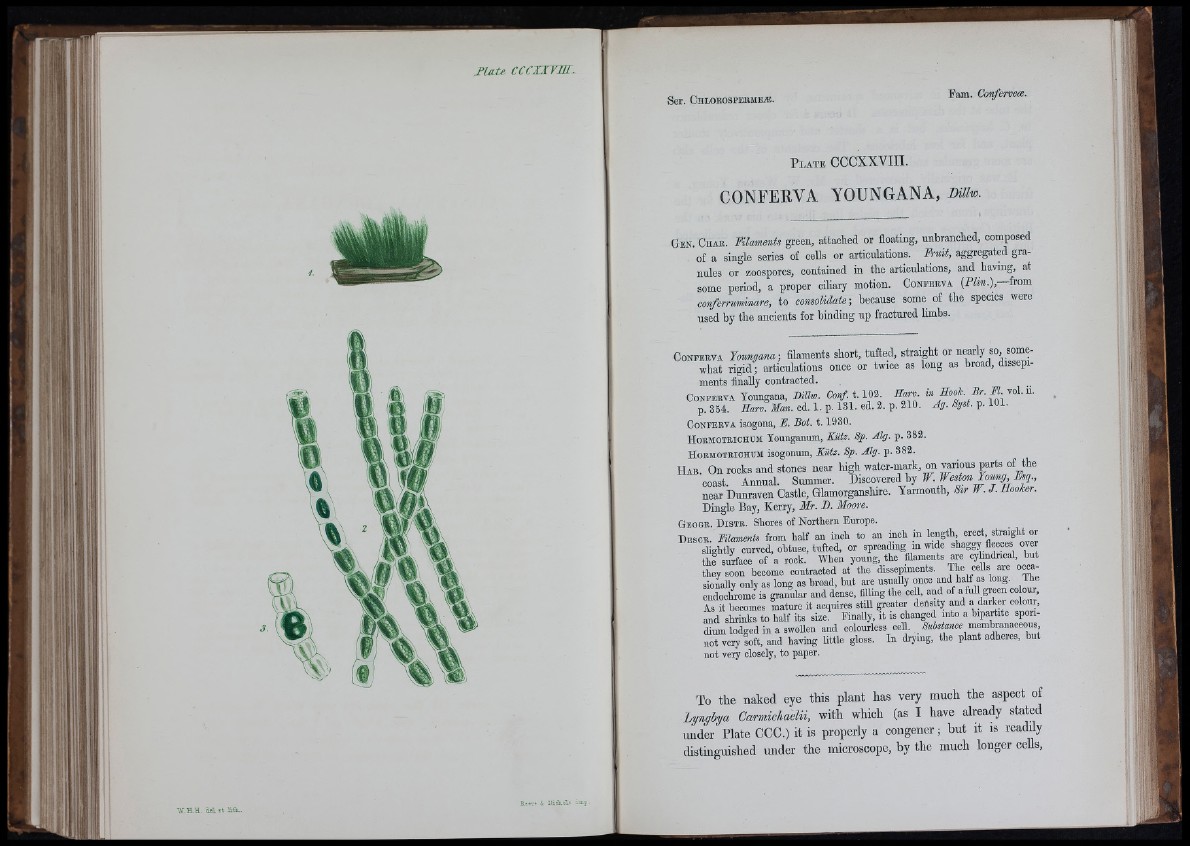
l u t f c c c r r rw .
B.ei>Tr In llirKoli imj.
P l a t e CCCXXVIII.
CONFERVA YOUNCANA, miiw.
Gen. Chab. VilamenU green, attached or floating, unbranohed, composed
of a single series of cells or articulations. Fruit, aggregated granules
or zoospores, contained in the articulations, and having, at
some period, a proper ciliary motion. Conserva (P fw .), from
conferruminare, to consolidate; because some of th e species were
used by tb e ancients for binding up fractured limbs.
Conferva Youngana; filaments short, tufted, straight or n e arly so somewhat
rigid; articulations once or twice as long as broad, dissepiments
finally contracted.
in Hook. Br. M. vol. ii.
Ag. Syst. p. 101.
CoNPEBVA Toungana, Dilho. Com/ . 1 .102. Harv.
p. 354. Harv. Man. ed. 1. p. 131. ed. 2. p. 210.
CoNEEBTA isogona, E. Bot. 1 .1930.
H o b m o t k i c h u m ; Yoanganum, Kütz. Sp. Alg. p. 382.
H o e m o t r i c h u m isogonum, Kütz. Sp. Alg. p. 382.
H a b . On rocks and stones near high water-mark, on various parts of the
coast. Annual. Summer. Discovered by
near Dunraven Castle, Glamorganshire. Yarmouth, 8%r W. J . Hooker.
Dingle Bay, Kerry, Mr. B . Moore.
Geoge . D is t e . Shores of Northern Europe.
D e sc e . Mlaments from half au inch to an inch in «''®ot straight or
slightly curved, obtuse, tufted, or spreading in wide shaggy fleeces over
the surface of a rock. When young, the filaments are cylindrical, but
they soon become contracted at the dissepiments. The cells are occa-
siouaUv only as long as broad, but are usuahy once and half as long. The
endochrome^s granular and dense, filling the cell, and of a fuU green co om,
As it becomes mature it acquires still greater deUsity and a darkei coloui,
and shrinks to half its size. FinaUy, it is changed into a bipartite spon-
dium lodged in a swoUen and colourless ceU. -SKfeimoe membranaceous,
not very toft, and having little gloss. In drying, the plant adheres, but
not very closely, to paper.
To the naked eye this plant has very much the aspect of
L y n g b y a C a rm ic h a e lii, with which (as I have already stated
under Plate CCC.) it is properly a congener; but it is readily
distinguished under the microscope, by the much longer cells.